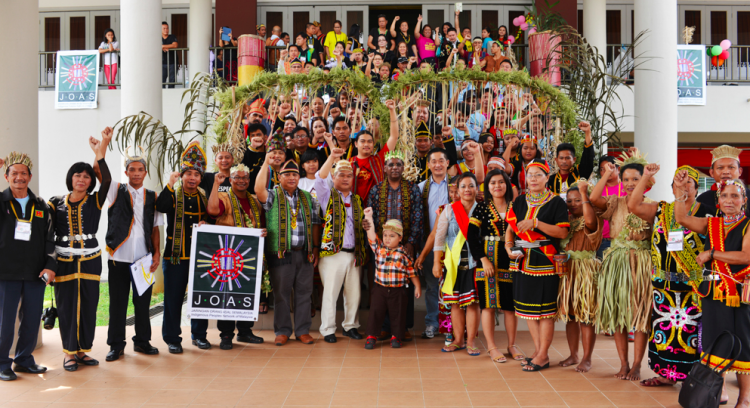9 August 2015
UN Secretary General Ban Ki Moon has stated, “The interests of the indigenous peoples must be part of the new development agenda in order for it to succeed. […] Together, let us recognize and celebrate the valuable and distinctive identities of indigenous peoples around the world. Let us work even harder to empower them and support their aspirations.”
In 1994, the UN General Assembly first marked 9 August as the International Day of the World’ Indigenous Peoples, as part of the first year celebration of the first UN Decade for Indigenous Peoples. For 21 years, we, indigenous peoples have been gaining landmark achievements at the global level with the establishment of the UN Permanent Forum on Indigenous Issues in 2000, the appointment of the Special Rapporteur on the rights of indigenous peoples, the adoption of the UN Declaration on the Rights of Indigenous Peoples in September 2007, the establishment of the UN Expert Mechanism on the Rights of Indigenous Peoples (EMRIP) in 2007 and the adoption of the Outcome Document of the World Conference of Indigenous Peoples in September 2014. All these gains have facilitated increased attention of the UN agencies, funds and programs and other public and private institutions to indigenous peoples who are 5% of the world population but 15% of the poorest.
Millions of indigenous peoples remain subjected to exploitation, systematic discrimination, militarization, conflicts and untold suffering from the widespread violation of our rights. Asia has 2/3 of the world’s indigenous peoples whose land rights are increasingly being violated even in countries where our land rights are recognized. Corporations and states in the name of “development and economic growth” are grabbing our lands.
Looking at the situation of indigenous peoples in the face of the renewed commitments of Asian States to the achievement of the ends of the UNDRIP, we see the governments’ failure in their obligations to respect, protect and fulfill the rights of indigenous peoples. In Cambodia, at least 45 indigenous communities have to defend their lands and resources from encroachment by economic land concessions (ELCs) and development projects. In Thailand, the increasing demarcation of land for national parks is resulting to the displacement of hill tribe communities regarded as “illegal settlements” although they had been living there for decades. In Malaysia, as the Orang Asal fight to retain their native customary rights (NCR) to their lands being grabbed for dams, plantations and parks, 300 land titles with NCR were found to have been issued to non-Orang Asal. In indigenous territories in North East India, Nepal, Malaysia and the Philippines, megadams are being constructed without the consent of affected indigenous communities.
Large-scale corporate mining remains to be the main issue of indigenous peoples in the Philippines along with the militarization of their territories. In India, adivasi villages and their forests are taken over by coal and bauxite mining in violation of the Forest Rights Act. Further, the bilateral agreement between India and Bangladesh over the exchange of territories at the border areas in North East India did not account for the land rights of indigenous peoples and their right to self-determination. In Nepal, despite the strong demand, land rights of the indigenous peoples and their right to self-determination are not guaranteed in the new draft Constitution. Furthermore, many of the indigenous communities hard hit by the earthquake in April 2015, experience discrimination in the relief and rehabilitation effort of the government and have not had substantive inputs to any rehabilitation plans of the government. In several countries, land grabbing has resulted to escalated intercommunity conflicts and access to justice remains a huge problem.
The violations of our rights to lands, territories and resources also disempower our indigenous women to assume their vital role and contribution to sustainable resource management, food security, protection of cultural heritage, and social cohesion, among others. The indigenous women’s vulnerability to violence is borne out of deprivation of land rights, lack of access to sustainable livelihoods and decent work, inadequate social services such as healthcare and education, violation of their rights as women, as well as out of various forms of conflict. Land grabbing and dispossession continue to push many women further into the informal economy, or migration for work and livelihoods, where they are open targets of exploitation and violence.
As legitimate actions to protect land and resources are pursued, indigenous peoples’ human rights defenders (IPHRDs) are criminalized resulting to arrests, detention, enforced disappearances and political killings. In Indonesia in May 2015, a list of 166 names of imprisoned indigenous human rights defenders charged with criminal offense by the Indonesian Government for defending their lands was submitted by AMAN, the national alliance of indigenous peoples of the archipelago, to President Joko Widodo DK for review. In the Philippines, between October 2014 to June 2015, 23 indigenous leaders were extrajudicially killed in Northern Mindanao Region in the Philippines alone, all working in defense of their lands and territories. That is almost three lives mercilessly killed every month. In Thailand, Pholachi Rakchongcharoen or Billy, a Karen activist remains missing since April 2014 after he was arrested by forest guards for illegal possession of honey from the forest.
Despite this worsening scenario, we, indigenous peoples are taking action and are gaining victories in defense of our lands, territories and resources. The demarcation of indigenous peoples’ land through community mapping has been a powerful tool to claim our land rights. In Indonesia, seven million hectares of ancestral territories have been mapped and AMAN has used their community maps in their legal claim to their customary forests resulting to a positive ruling of the Constitutional Court that customary forests are NOT state forests.
In Malaysia and India, community maps were granted legal recognition through land titles. Likewise, the ongoing blockade by Kayan, Kenyah and Penan indigenous peoples in Sarawak since October 2013 temporarily halted the construction of the Baram Dam, which will displace 20,000 indigenous villagers. Sustained community actions with the active participation of indigenous women also prevented the opening of another bauxite mining in the tribal belt of India. We have documented our good practices in climate change mitigation and adaptation and have been actively engaged with REDD bodies among others at the national level. We are engaging with governments for policy reforms for the protection of our collective rights. Likewise, Indigenous peoples are now making use of international accountability mechanisms such as the Compliance Advisor Ombudsman (CAO) and Inspection panel of the World Bank (Cambodia and Nepal) and OECD country focal points (Malaysia) against corporations violating indigenous peoples’ rights.
We continue to call upon states to take concrete actions to respect, recognize and protect our collective rights as affirmed by the UN Declaration on the Rights of Indigenous peoples. The post 2015 Development Agenda as well as climate change solutions and actions shall fully respect and protect our rights especially to our lands, territories and resources.
As we celebrate the International Day of World’s Indigenous Peoples, let us be inspired by our achievements in defense of our rights and dignity. Let us celebrate our diverse cultures and be proud of who we are. Let us also remember and commemorate the indigenous men and women– our heroes and martyrs who have sacrificed their lives in defense of our rights. They have enriched our land with their sweat and blood and we shall remain steadfast in defending our lands and cultural heritage for the present and future generations. Let us strengthen our unity and solidarity as we broaden our linkages and collaboration with other sectors and advocates in advancing our common vision for peace, justice and prosperity for all.
Our lands are not for sale,
Our lands are not for profit.
LAND RIGHTS NOW!

